UPSC Daily Current Affairs -18th November 2024 | Current Affairs & Hindu Analysis: Daily, Weekly & Monthly PDF Download
GS3/Science and Technology
Epilepsy
Source: Times of India

Why in News?
National Epilepsy Day is marked every year in India on November 17 to raise awareness about the disease, the struggles associated with it, and the importance of early diagnosis and treatment.
About Epilepsy:
- Epilepsy, also referred to as a seizure disorder, is a long-term brain condition where nerve cells do not send signals correctly, leading to repeated seizures.
- During a seizure, many neurons send signals simultaneously and much faster than usual.
- This burst of extra electrical activity can result in involuntary movements, sensations, feelings, and behaviors.
- The disruption in normal nerve cell function may lead to a loss of awareness.
- Some individuals recover right after a seizure, while others may take minutes or even hours to return to normal.
- Causes:
- There are many potential causes of epilepsy, but about half of those affected do not know what causes their condition.
- In certain cases, epilepsy is clearly connected to genetics, brain development issues, infections, traumatic brain injuries (TBI), strokes, brain tumors, or other identifiable issues.
- Seizure symptomscan differ greatly:
- Some individuals may lose awareness during a seizure, while others remain aware.
- Some may stare blankly for a few seconds during a seizure.
- Others might have convulsions, which are repeated twitching movements of their arms or legs.
- Having one seizure does not necessarily mean a person has epilepsy. A diagnosis of epilepsy is made when someone has experienced at least two unprovoked seizures that occur at least 24 hours apart.
- Anyone can develop epilepsy; it affects both men and women from all races, ethnic backgrounds, and ages.
- Approximately 50 million people globally have epilepsy, making it one of the most widespread neurological disorders.
- Treatment:
- Medications or, in some cases, surgery can help control seizures for most individuals with epilepsy.
- Some may require treatment for their entire lives, while others may find that their seizures stop.
- Some children with epilepsy may outgrow the condition as they get older.
GS 1/Geography
Midnight Zone
Source: NDTV
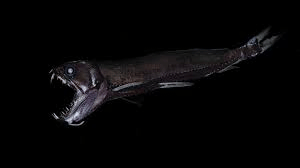
Why in News?
A team of researchers recently discovered a glowing “mystery mollusk” named Bathydevius Caudactylus within the ocean's midnight zone.
About Midnight Zone:
Zones of the Ocean Water Column
- Sunlight Zone (Epi-pelagic). This is the uppermost layer where sunlight penetrates, allowing photosynthesis to occur. It is rich in marine life due to the availability of light and warmth.
- Twilight Zone (Meso-pelagic). In this zone, light begins to fade, and the temperature drops. It is home to various species that can adapt to lower light conditions.
- Midnight Zone (Bathypelagic). Also known as the bathypelagic zone, this area is characterized by complete darkness as no light penetrates this deep. It extends from about 1,000 meters to 4,000 meters (about 3,300 to 13,100 feet). This zone makes up 70% of the ocean's water and is the largest habitat on Earth. The temperature here is around 4° Celsius (39° Fahrenheit), and the pressure ranges from 100 to 400 atmospheres. Organisms in this zone have adapted to the cold and high pressure, with features like bioluminescence, advanced visual and auditory systems, and the ability to withstand extreme conditions.
- Abyssal Zone (Abyssopelagic). This zone includes the ocean floor in deep areas. It is similar to the midnight zone in terms of darkness and pressure but is characterized by specific geological features.
- Hadal Zone (Trenches). This zone encompasses the deepest parts of the ocean, including trenches. It is marked by extreme pressure and unique ecosystems.
Light Penetration in Water
- As sunlight travels through water, it is quickly absorbed. The red, orange, and yellow wavelengths are absorbed first, which is why deep ocean water appears a brilliant blue. However, even these wavelengths disappear as light goes deeper into the water.
- By around 1,000 meters (about 3,300 feet) deep, even the faintest light is gone, leaving these deep ocean waters in constant darkness.
Midnight Zone (Bathypelagic Zone)
- The midnight zone extends from about 1,000 meters to 4,000 meters (about 3,300 to 13,100 feet) deep, often reaching the ocean floor.
- This zone is the largest habitat on Earth, making up 70% of all seawater.
- It is characterized by a constant temperature of around 4° Celsius (39° Fahrenheit) and extreme hydrostatic pressure, which varies with depth.
- Pressure in this zone ranges from 100 to 400 atmospheres.
- Organisms in the midnight zone have special adaptations to survive in these conditions, such as:
- Well-developed visual systems to see in the dark
- Bioluminescence to attract prey or mates
- Well-developed auditory systems to hear other animals nearby
Discovery of Bathydevius Caudactylus
- New Mollusk Species: Bathydevius caudactylus is a recently discovered species of mollusk found in the ocean's midnight zone.
- Unique Sea Slug: Despite being classified as a sea slug, this marine animal is unlike any other sea slug previously known to scientists.
- Bioluminescent Swimming Sea Slug: Bathydevius is a swimming sea slug that glows with bioluminescence. It has a paddle-like tail and a large gelatinous hood. This species is the first sea slug identified to live in the deep ocean.
- Habitat: Typically, sea slugs inhabit the seafloor or coastal areas like tide pools. Only a few species are known to live in open water near the surface. Bathydevius, however, thrives in the deep ocean.
- Movement: Bathydevius moves up and down the water column by flexing its body or drifting with the currents.
- Reproductive System: Bathydevius is a hermaphrodite, possessing both male and female reproductive organs.
GS3/Science and Technology
Long-Range Hypersonic Missile
Source: Hindustan Times
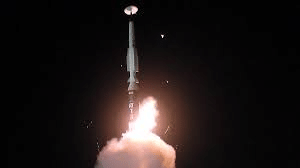
Why in News?
India’s Defence Research and Development Organisation (DRDO) successfully flight-tested a long-range hypersonic missile off the coast of Odisha.
About Long-Range Hypersonic Missile:
- The missile is capable of carrying different types of payloads over distances exceeding 1,500 kilometers for the Armed Forces.
- It has been developed indigenously by the laboratories at the Dr. APJ Abdul Kalam Missile Complex in Hyderabad, in collaboration with various other DRDO (Defence Research and Development Organisation) labs and industry partners.
What are Hypersonic Missiles?
- Definition of Hypersonic: Hypersonic refers to speeds that are at least five times the speed of sound, known as Mach-5.
- Maneuverability: Hypersonic missiles are highly maneuverable, which distinguishes them from ballistic missiles that follow a predetermined path.
- Hypersonic Cruise Missiles: These missiles utilize scramjet engines to maintain hypersonic speeds throughout their flight. They operate at lower altitudes and possess advanced maneuverability.
- Types of Hypersonic Weapons Systems:
- Hypersonic Glide Vehicles (HGV): These are launched from a rocket and glide towards the target.
- Hypersonic Cruise Missiles (HCM): These are powered by air-breathing high-speed engines, known as scramjets, after acquiring their target.
Advantages of Hypersonic Missiles
- Hypersonic weapons offer responsive and long-range strike options against distant, defended, or time-sensitive threats, such as mobile missile launchers, especially when other forces are unavailable or access is denied.
- Conventional hypersonic weapons rely solely on kinetic energy, which is energy derived from motion, to destroy targets. This includes unhardened targets and even underground facilities.
- These weapons fly at lower altitudes compared to ballistic missiles, making them potentially harder to track at long distances by certain surface-based sensors, such as specific radar systems.
- Global Development: Russia and China are believed to be leading in the development of hypersonic missiles, while the United States is also advancing a range of hypersonic weaponry under an ambitious program.
GS3/Environment and Ecology
Nugu Wildlife Sanctuary
Source: The Hindu
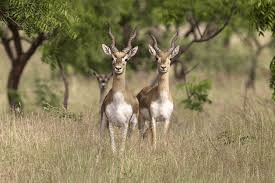
Why in News?
The recommendations of the National Tiger Conservation Authority (NTCA) to notify the entire Nugu Wildlife Sanctuary as a core and critical area of Bandipur Tiger Reserve are yet to be implemented.
About
- Location: Nugu Wildlife Sanctuary is located in the H.D. Kote taluk of Mysuru district in Karnataka, India. It is situated to the north of Bandipur National Park.
- Geography: The sanctuary features the backwaters of Nugu Dam on its western side. It shares borders with Alaganchi State Forest, which is part of the Bandipur Tiger Reserve, on the southwest. Nugu Dam is built across the Nugu River, a tributary of the Cauvery River. The sanctuary is also an integral part of the Nilgiri Biosphere Reserve.
- Rainfall: The area receives rainfall from both the southwest and northeast monsoons, with an average annual rainfall of around 1000 mm.
- Vegetation: The forests in the sanctuary consist of southern mixed deciduous trees and dry deciduous scrubs.
- Flora: Notable tree species found in the region include Dipterocarpus indicus, Calophyllum tomentosum, and Hopea parviflora.
- Fauna:Nugu Wildlife Sanctuary is home to a diverse range of wildlife, including:
- Mammals: Elephants, tigers, leopards, wild dogs, striped hyenas, sloth bears, gaurs, sambars, chitals, and four-horned antelopes.
- Riverine Species: The sanctuary is also home to important riverine wildlife species such as the smooth-coated otter and the marsh crocodile, highlighting its rich biodiversity.
GS1/Geography
Key Facts about Dead Sea
Source: World Vision
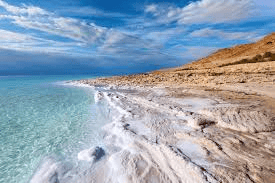
Why in News?
Researchers have discovered meter-high chimneys on the floor of the Dead Sea formed by the spontaneous crystallization of minerals from groundwater with an extremely high salt content flowing up out of the lake floor.
About the Dead Sea
- The Dead Sea, often called the Salt Sea, is a highly saline lake situated in southwestern Asia, bordered by Jordan to the east and Israel to the west.
- The eastern shore of the Dead Sea is in Jordan, while the western shore is divided between Israel and the West Bank. The southern part of the western shore belongs to Israel, while the northern part is in the West Bank, a region claimed by both Israel and Palestine.
- Geographically, the Dead Sea is located east of the Mediterranean Sea and south of the Sea of Galilee. It is situated at an elevation of 430.5 meters below sea level, making it the lowest land-based point on Earth.
- The lake covers an area of approximately 605 square kilometers, stretching about 50 kilometers in length and 15 kilometers in width at its widest point.
Salinity
- The Dead Sea is renowned for its extreme salinity, which is nearly ten times greater than that of ordinary seawater, with a salinity level of 34.2%. This makes it the fourth saltiest body of water in the world, surpassed only by Antarctica’s Don Juan Pond and Lake Vanda, and Djibouti’s Lake Assal.
- The Dead Sea has only one main inlet, the Jordan River, and does not have an outlet. Water is lost mainly through evaporation, contributing to its high salinity. The extreme salt concentration, along with the harsh climate, creates an environment where most life forms cannot survive, except for certain algae and microorganisms.
- The density of the water in the Dead Sea is about 1.240 kg/L, which allows people to float easily on its surface, making swimming a unique experience.
GS1/Geography
Willingdon Island
Source: Times of India

Why in News?
Rejuvenation of Willingdon Island, once a bustling hub for port-related activities, has taken centre stage in discussions at trade union forums, with calls for concrete measures to restart its commercial operations.
About Willingdon Island
- Willingdon Island is a picturesque spot in the Kochi region of Kerala.
- It is a man-made island named after Lord Willingdon, who was a British Viceroy of India.
- The island is one of the largest of its kind in India.
- Willingdon Island houses important facilities such as the Kochi Naval Base, the Central Institute of Fisheries Technology, and the Port of Kochi.
- The island is connected to the mainland by the Venduruthy Bridge.
Who was Lord Willingdon (1931 - 1936)?
- Lord Willingdon was the 22nd Viceroy and Governor-General of India.
- During his tenure, several significant events took place, including the introduction of the Government of India Act in 1935.
- The Second Round Table Conference in 1931 involved Gandhi representing the Congress.
- In 1932, British Prime Minister Ramsay MacDonald introduced the Communal Award, and the Poona Pact was reached between Gandhi and Ambedkar to ensure fair representation for backward classes.
- The Third Round Table Conference in 1932 was unsuccessful as Gandhi and the Congress did not attend.
GS2/International Relations
 |
Download the notes
UPSC Daily Current Affairs -18th November 2024
|
Download as PDF |
Will Riyadh summit have an impact on Gaza war?
Source: The Hindu

Why in News?
Saudi Arabia recently hosted a summit of Arab and Islamic leaders, urging an immediate halt to Israel’s military actions in Gaza and Lebanon while addressing the broader Palestine issue.
Key Outcomes of the Riyadh Summit on the Gaza Conflict
- Condemnation of Israeli Actions: Leaders from Arab and Islamic countries condemned the Israeli military’s actions in Gaza, describing them as “shocking and horrific crimes,” including accusations of genocide and ethnic cleansing.
- Call for Investigation: They demanded the establishment of an “independent, credible” international committee to investigate these alleged crimes committed by Israel.
- Support for Palestinian Statehood: The summit urged for measures to end the Israeli occupation and called for the establishment of an independent Palestinian state based on the borders prior to June 4, 1967, with East Jerusalem (Al-Quds) as its capital, aligning with the two-state solution and the Arab Peace Initiative of 2002.
Changing Dynamics in Regional Politics
- Shift from Normalization: The summit reflects a significant shift in regional politics where Arab nations, which had previously moved towards normalizing relations with Israel (as seen in the Abraham Accords), are now re-emphasizing the importance of addressing the Palestinian issue as a prerequisite for peace.
- Collective Arab Stance: The gathering showcased a united front among Arab leaders in response to Israel’s actions, indicating a collective anger and a strategic pivot back towards supporting Palestinian rights rather than sidelining them for diplomatic ties with Israel.
- Impact on Saudi-Israel Relations: Saudi Crown Prince Mohammed bin Salman’s strong condemnation of Israel’s actions signals a deterioration in potential normalization talks with Israel, as any future agreements are now explicitly linked to resolving the Palestinian question.
Possibility of the Arab World Joining the War
- Unlikelihood of Military Action: Despite heightened tensions and strong rhetoric, it is highly unlikely that any Arab nation will engage militarily against Israel. Historical precedents show that while Arab states have condemned Israeli actions, they have refrained from direct military confrontation since 1973.
- Focus on Diplomatic Solutions: The current sentiment among Arab nations leans towards seeking diplomatic resolutions rather than military involvement, especially given their previous moves towards normalizing relations with Israel.
- Strategic Realignment: The recent developments suggest a subtle realignment in West Asia’s strategic landscape, where Arab states may prioritize internal stability and regional cooperation over direct military engagement, even as they express solidarity with Palestine.
India’s Role in Resolving the Gaza Conflict
- Mediation and Dialogue Facilitation: India can leverage its strong relationships with both Arab countries and Israel to act as a neutral mediator, facilitating dialogue and promoting peaceful negotiations between the conflicting parties.
- Support for International Initiatives: India can advocate for a renewed focus on the two-state solution within international forums like the UN, aligning with global efforts to establish a sustainable, independent Palestinian state alongside Israel.
Way Forward
- Strengthen Diplomatic Efforts: Arab nations should focus on reinforcing diplomatic pressure on Israel and the international community to address the Palestinian issue, promoting dialogue and supporting peaceful resolutions.
- Support Palestinian Unity: Arab countries should work towards fostering unity within Palestinian leadership to present a coherent political front and advance their cause for statehood in international forums.
GS3/Defence and Security
Operation Sagar Manthan
Source: Times of India
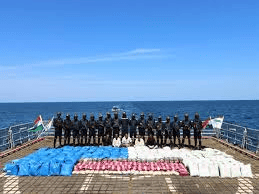
Why in News?
The Narcotics Control Bureau (NCB) has initiated Operation Sagar Manthan to dismantle the extensive drug empire of Haji Salim, also known as the “Lord of Drugs”.
About Operation Sagar Manthan
| Details | |
| About the Operation | • An initiative by Narcotics Control Bureau (NCB) to dismantle the drug trafficking network led by Haji Salim. • Launched under the direction of Union Home Minister Amit Shah. • A comprehensive crackdown on Salim’s syndicate linked to narco-terrorism. |
| Aims and Objectives | • Break supply lines, seize narcotics, and arrest operatives. • Disrupt funding for cross-border terrorism. • Strengthen surveillance in remote coastal areas used by the syndicate. • Counter aid from entities like Pakistan’s ISI and disrupt links with figures like Dawood Ibrahim. |
| Goals | • Reduce cartel influence in the Indian Ocean region. • Mitigate narco-terrorism to enhance regional security. • Improve maritime security to prevent future networks. |
Why does the government crack down on drug trafficking?
- Public Health Protection: Drug trafficking leads to addiction, mental health problems, and diseases. This puts a lot of pressure on healthcare systems and harms the well-being of society.
- National Security and Social Stability: It supports organized crime, terrorism, and violence. This creates instability in communities, weakens governance, and disrupts law and order.
GS3/Environment and Ecology
Species in News: Kaalinga
Source: The Hindu

Why in News?
About Kaalinga (Ophiophagus kaalinga)The Western Ghats’ king cobra, commonly called ‘Kalinga Sarpa’, will soon be recognized in the scientific community as Ophiophagus kaalinga.
| Details | |
| Geographical Location | • Native to the Western Ghats of Karnataka, India, and extends to adjacent regions within the Western Ghats. • Prefers dense tropical forests and hilly terrains. |
| Physical Features | • Can grow up to 10-12 feet. • Carnivorous, feeding on snakes, small mammals, and lizards. • Potent neurotoxic venom capable of killing several humans or an elephant in a single bite. |
| Uniqueness | • Known for territorial behaviour and intelligence. • Females build and fiercely guard nests (4 ft x 3 ft) with 23-43 eggs per clutch. |
| Conservation Status | • At risk due to habitat fragmentation, human-animal conflict, and the absence of specific anti-venom. IUCN Status: Vulnerable WPA, 1972: Schedule II (accorded protection but with lesser restrictions compared to Schedule I) |
|
39 videos|4549 docs|972 tests
|
FAQs on UPSC Daily Current Affairs -18th November 2024 - Current Affairs & Hindu Analysis: Daily, Weekly & Monthly
| 1. What is epilepsy and what are its common symptoms? |  |
| 2. What is the significance of the Midnight Zone in oceanography? |  |
| 3. What capabilities do Long-Range Hypersonic Missiles possess? |  |
| 4. What are the key features of Nugu Wildlife Sanctuary? |  |
| 5. How might the Riyadh summit influence the Gaza war? |  |


























